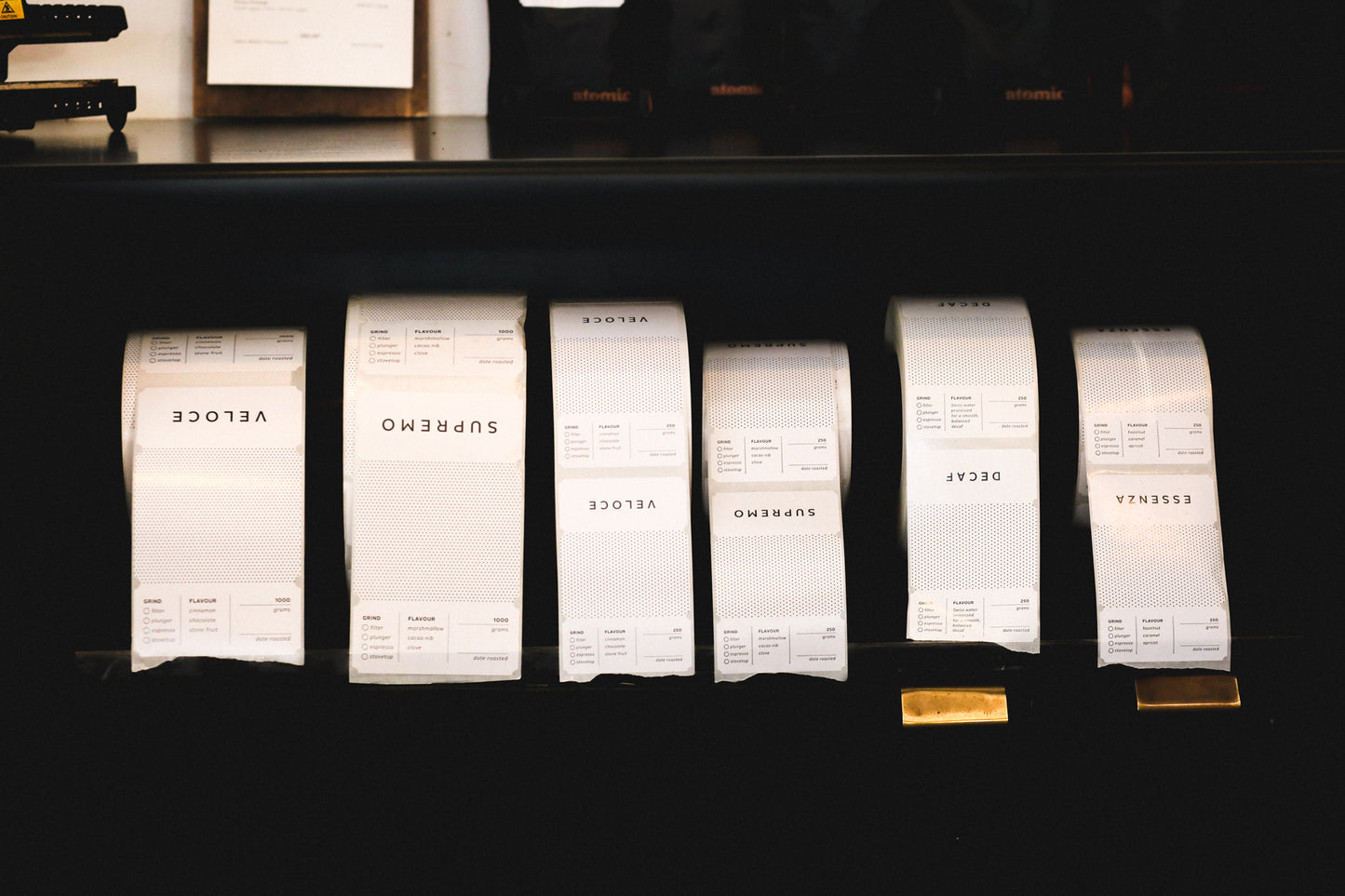
Do you drink coffee at home? Do you get your morning brew from a cafe? Then there’s a pretty high chance that what you’re sipping on is what roasters call ‘a blend’. It’s hard to find an espresso-based coffee in New Zealand that isn’t a blend, whether it’s coming out of your local’s espresso machine or lined up on the supermarket shelves. You might have spotted the word on the packaging, or on tasting cards by the grinder.
But what is a blend?
BLEND VS SINGLE ORIGIN
In coffee terms, a blend refers to mixing two or more coffees from a variety of provenance, a.k.a ‘origins’. By that, we mean either a country, a region within a country, or even a specific coffee farm.
Now you may think that coffee just tastes like ‘coffee’. But each coffee origin, or growing region, comes with what we call ‘terroir’: different growing conditions, soil composition, growing altitude, etc. And all of this has an impact on the flavours, which means different coffee origins tend to have a set of flavour characteristics: fruit-forward and juicy for Ethiopia, or nutty, chocolatey and rich for Brazil, etc.
When you buy and brew a ‘single origin’ coffee, these unique characteristics really shine through. That’s why we tend to recommend soft-brewing extraction methods like filter or AeroPress for our single origins - so we can highlight their amazing, fragrant flavours in a gentle way.
But when it comes to espresso, we’re using pressure to extract solubles from the coffee grinds, which tends to amplify and intensify these unique characteristics and, sometimes, that might lead to a pretty sharp drinking experience.
By blending origins, we aim to create a complex but balanced flavour profile, one that draws from the characteristics of each blend component and is suited to espresso extraction.

WHY BLEND COFFEES?
It’s pretty common practice in New Zealand to blend coffees for espresso, and especially milk-based drinks. The goal for coffee roasters is to create a harmonious and balanced product that is consistent all year round.
Roasters select their blend components with a distinctive flavour profile in mind. Typically, a roaster’s house blend tries to appeal to a wide audience of coffee drinkers, so it needs to be versatile (i.e taste great black or through milk, including alternatives).
The ultimate goal is to create a well-rounded, harmonious drinking experience. Think of it like a well-seasoned dish, with sweetness, acidity and body/mouthfeel balancing one-another, tasting 'whole' rather than layered.
Another reason roasters blend coffee is to keep that tasty profile consistent. Coffee is a seasonal agricultural product that usually gets harvested once a year and ages, and that is subject to change. Just like wine grapes, the quality of the harvest might vary from one year to the next. Coffee also gets shipped from halfway around the globe, from countries that might be experiencing social unrest, natural disasters, or other events that would have an impact on accessibility and price. So by blending origins, we can mitigate these issues - tweak the roast profile of components, swap them out for a new component that will play a similar role in the blend, or adjust the percentage of the component in the overall composition of the blend. Which leads us to the more technical side of blending…

HOW TO BLEND COFFEE
A lot of the blending process happens before the coffees are roasted, and require a bit of trial and error. We work backwards from a preferred taste profile, then look for coffees that could contribute to that profile.
The assessment of the beans is done through ‘cupping’, which is basically brewing and slurping coffee in a methodical and always-replicated way, which helps create an ‘objective’ taste assessment. We taste the coffees for attributes like sweetness, acidity and mouthfeel/body as well as flavour notes (caramel, chocolate, nutty, sweet, and use this data to pair coffees together and establish a ratio. That’s when the real trial and error starts, trying to reach the best percentage of each component for our blend.
Once that’s locked in, it's time to roast. There’s two ways to go about this: either pre-blending or post-blending. Pre-blending means blending our components while the coffee is still green, and roasting it already blended. The issue with pre-blending is that it doesn’t account for the specificities of raw green coffee beans, like density and moisture content, which will have an impact on the way they need to be roasted, from temperature of the roaster to duration of the roast.
At Atomic, we opt for post-blending: our blend components are roasted individually, so we get exactly what we’re after. Once our components are all roasters to their own sweet spot, we blend them together to the predetermined ratio.

ATOMIC’S BLENDS
There’s a virtually infinite amount of combinations roasters can do, which means there’s a lot of blends out there. It can be hard to figure out which one’s best suited to your taste or equipment, so whenever possible, check out the label for extra info or ask the barista behind the counter for some guidance.
At Atomic, we’ve created three main blends, to satisfy a range of palates:
- VELOCE: our house-blend. Build on a Brazil base for the chocolate notes and rich body, but with well-balanced stone-fruit acidity. Created with milk-coffee drinkers in mind, it’s super complex even as a bowl latte.
- SUPREMO: with Supremo, we’re putting the emphasis on the body. It’s a really creamy blend with lots of sweetness but mild acidity. As an espresso, you’ll get strong dark cacao flavours but a soft floral finish - super complex.
- ESSENZA: it’s our fully fairtrade organic blend. Fewer components and an emphasis on sweetness and acidity. A great choice for those who prefer the sweetness of caramel in their milky espresso, or for black coffee drinkers who lean on the fruitier side.
Went to know more about blending and coffee in general? Check out our Intro to Espresso classes.
